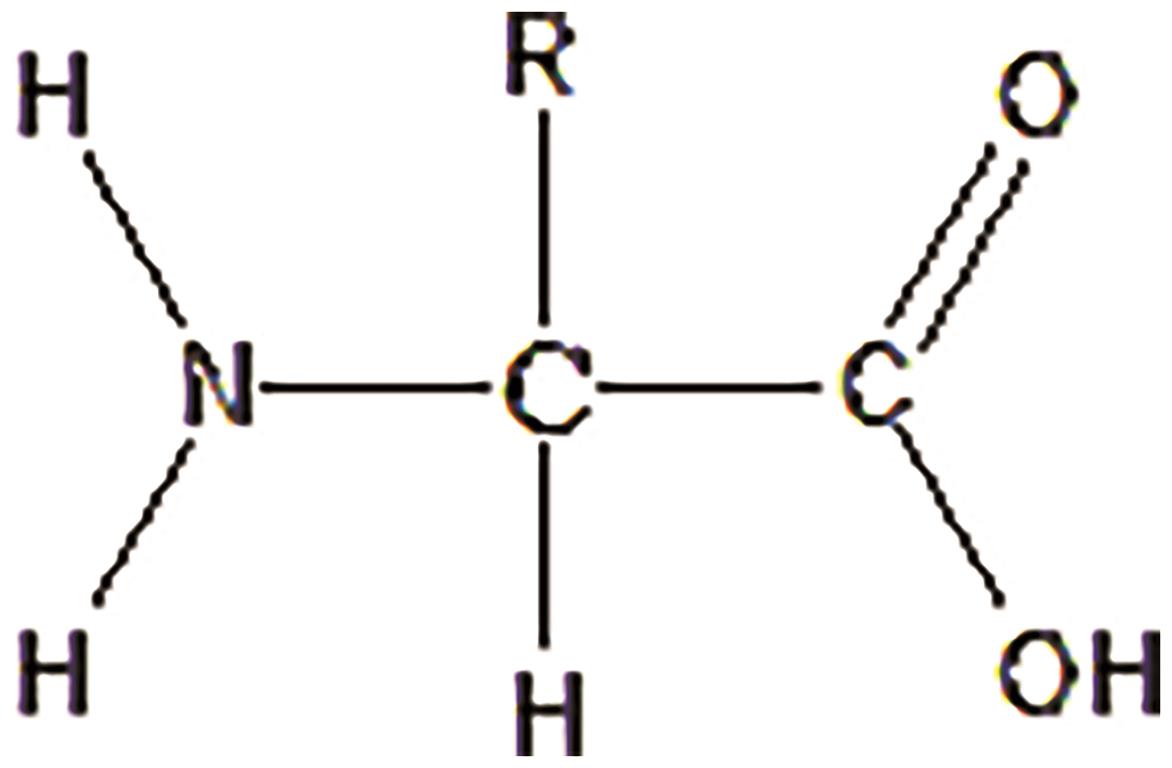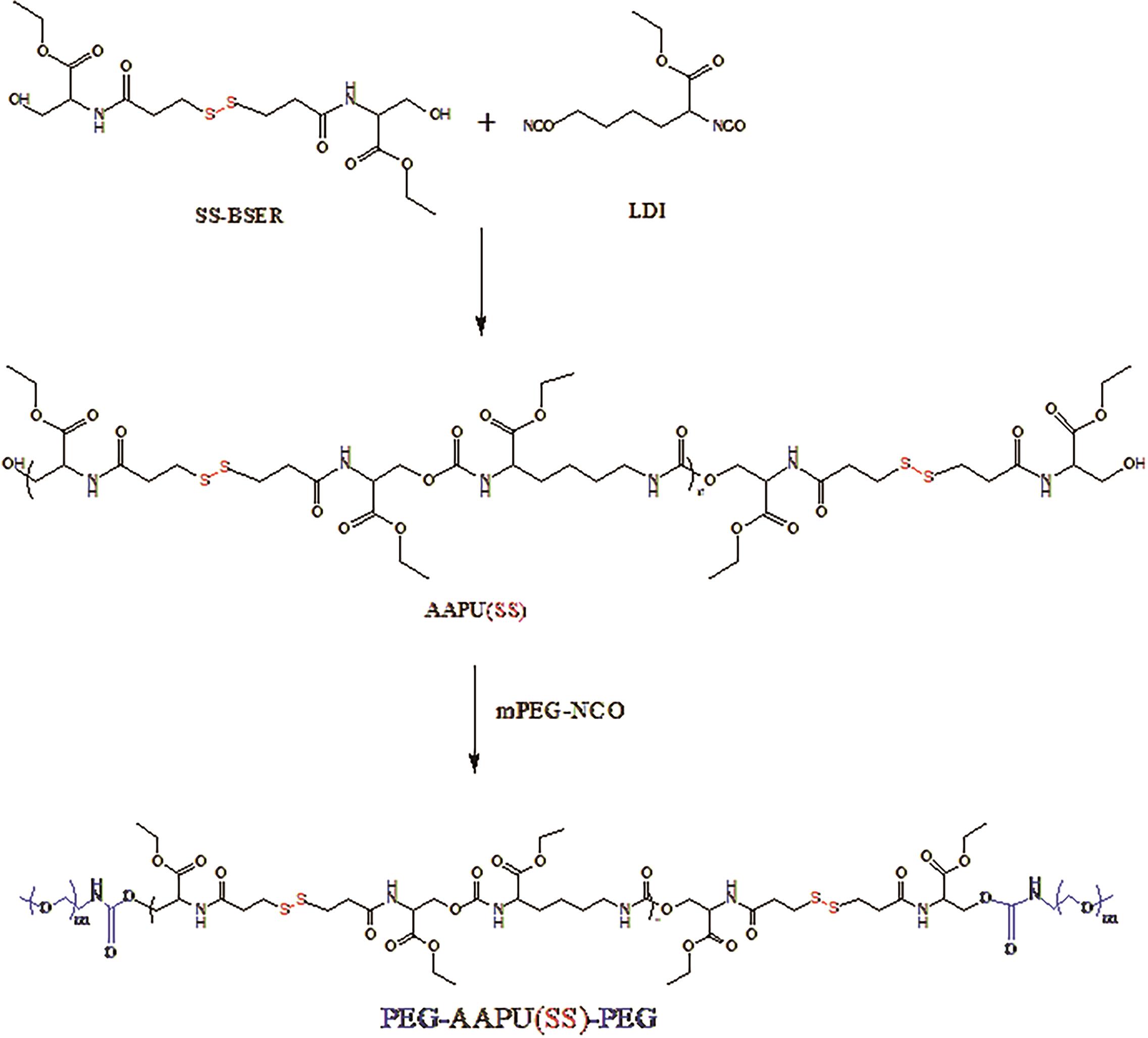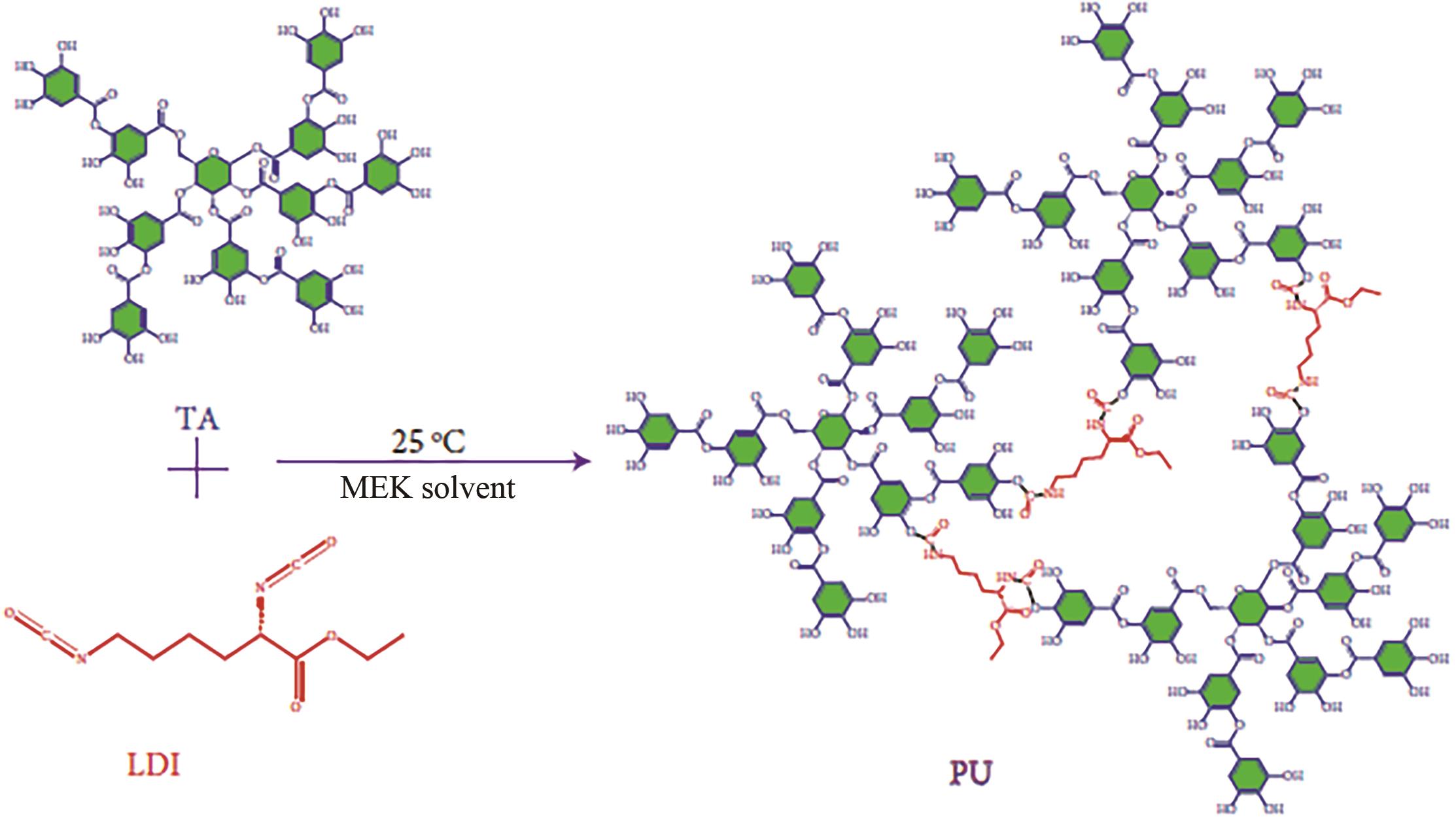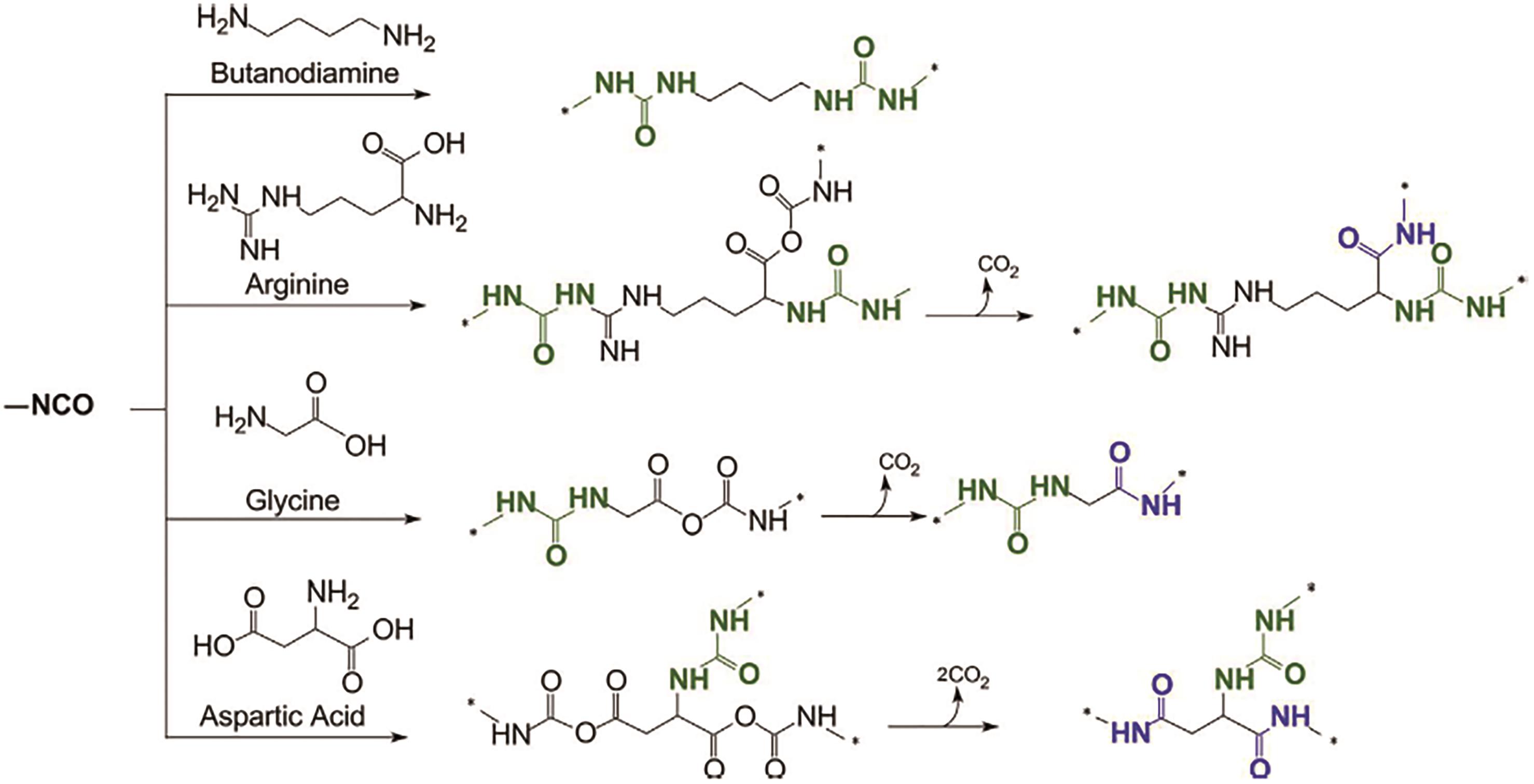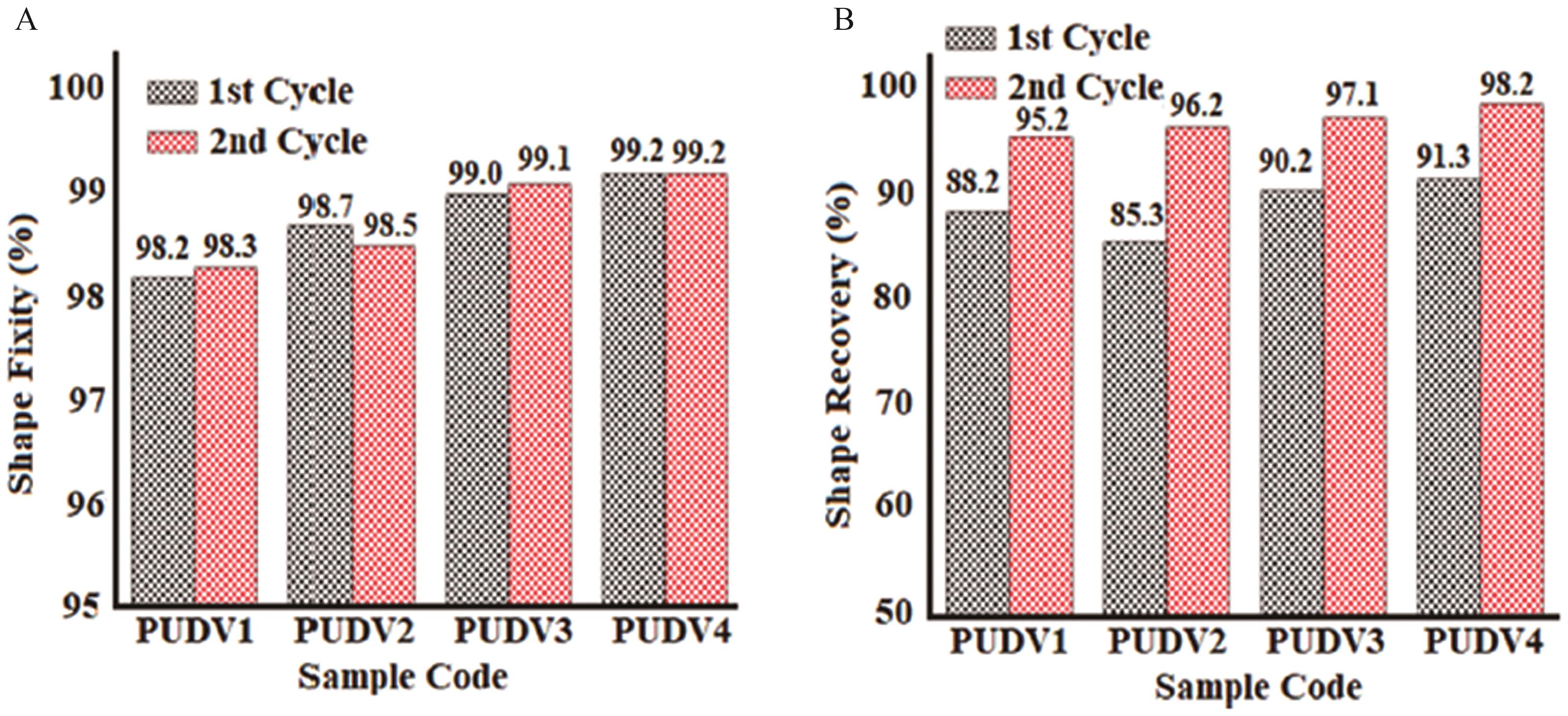
应用化学 ›› 2025, Vol. 42 ›› Issue (1): 42-57.DOI: 10.19894/j.issn.1000-0518.240294
氨基酸及其衍生物的生物基聚氨酯的制备和性能的研究进展
唐国鸿1,2, 赵振3, 仲家慧1,2, 徐小玲1,2, 孙莹潞1, 盛德鲲1, 杨宇明1,2( )
)
- 1.中国科学院长春应用化学研究所,高性能合成橡胶及其复合材料重点实验室,长春 130022
2.中国科学技术大学,合肥 230026
3.空军装备部驻长春地区军事代表室,长春 130000
-
收稿日期:2024-09-06接受日期:2024-11-27出版日期:2025-01-01发布日期:2025-01-24 -
通讯作者:杨宇明 -
基金资助:国家自然科学基金面上项目(22175171);吉林省自然科学基金(SKL202302036)
Research Progress on Preparation and Properties of Bio-Based Polyurethanes from Amino Acid and Its Derivatives
Guo-Hong TANG1,2, Zhen ZHAO3, Jia-Hui ZHONG1,2, Xiao-Ling XU1,2, Ying-Lu SUN1, De-Kun SHENG1, Yu-Ming YANG1,2( )
)
- 1.CAS Key Laboratory of High-Performance Synthetic Rubber and Its Composite Material,Changchun Institute of Applied Chemistry,Chinese Academy of Science,Changchun 130022,China
2.University of Science and Technology of China,Hefei 230026,China
3.Military Representative Office of the Air Force Armament Department in Changchun,Changchun 130000,China
-
Received:2024-09-06Accepted:2024-11-27Published:2025-01-01Online:2025-01-24 -
Contact:Yu-Ming YANG -
About author:ymyang@ciac.ac.cn
-
Supported by:the National Natural Science Foundation of China(22175171);the Natural Science Foundation of Jilin Province of China(SKL202302036)
摘要:
生物基原料作为一种可再生资源,与石油基原料相比具有污染小、易回收等特点。 使用生物基原料合成聚氨酯的研究已经相当广泛,可以用于聚氨酯合成的生物基原料的种类也非常丰富。 氨基酸是一种常用的生物基原料,其结构多样,原料易得,具有良好的反应活性,并且降解产物无毒无害。 使用氨基酸作为原料合成生物基材料的方法已经较为常用。 对氨基酸及其衍生物在生物基聚氨酯合成中的应用进行了介绍,阐述了氨基酸作为不同部分参与到聚氨酯合成的方法路线以及由氨基酸及其衍生物合成的聚氨酯的结构与性能的关系,并对氨基酸及生物基聚氨酯的未来发展进行了展望。
中图分类号:
引用本文
唐国鸿, 赵振, 仲家慧, 徐小玲, 孙莹潞, 盛德鲲, 杨宇明. 氨基酸及其衍生物的生物基聚氨酯的制备和性能的研究进展[J]. 应用化学, 2025, 42(1): 42-57.
Guo-Hong TANG, Zhen ZHAO, Jia-Hui ZHONG, Xiao-Ling XU, Ying-Lu SUN, De-Kun SHENG, Yu-Ming YANG. Research Progress on Preparation and Properties of Bio-Based Polyurethanes from Amino Acid and Its Derivatives[J]. Chinese Journal of Applied Chemistry, 2025, 42(1): 42-57.
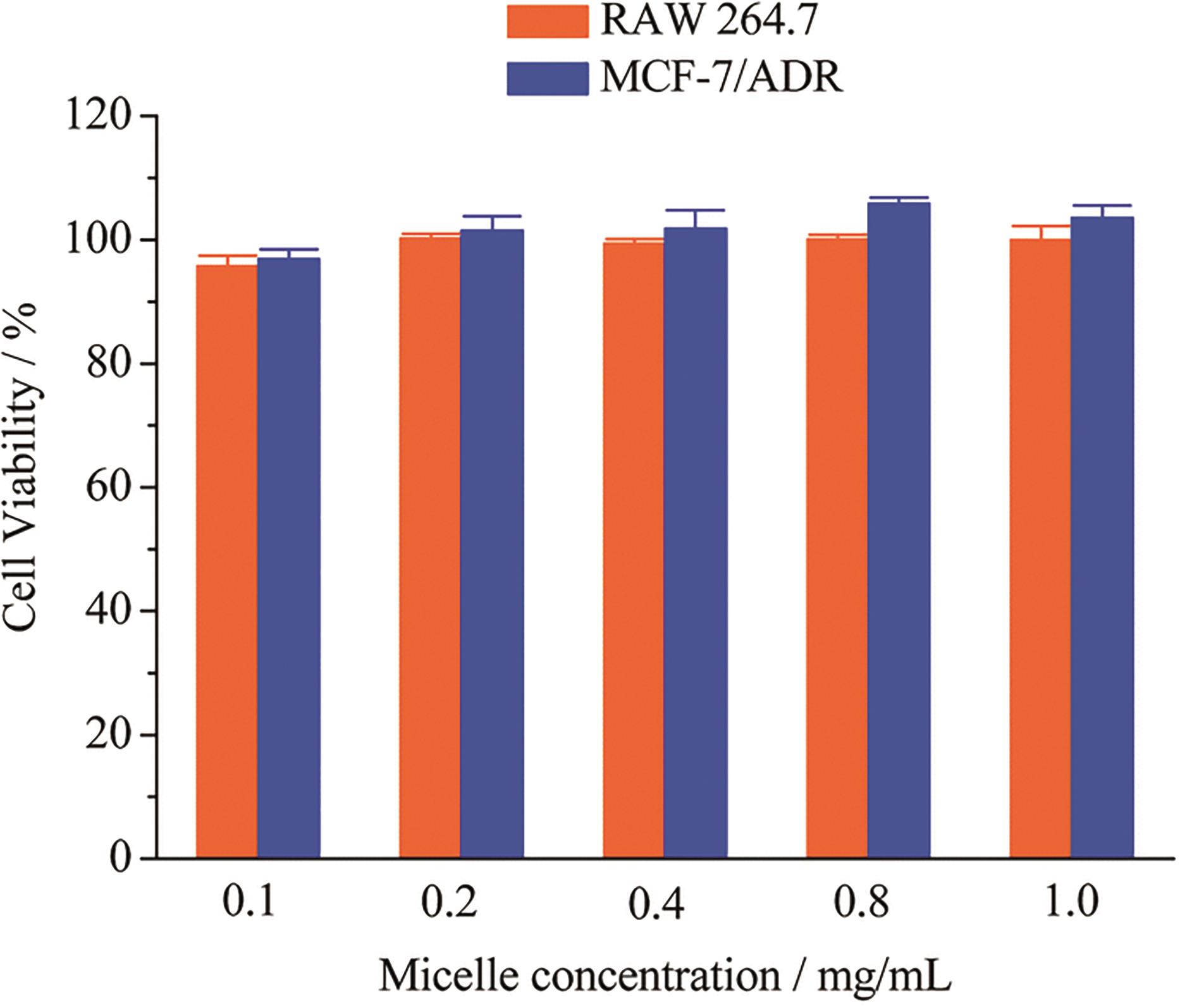
图3 RAW264.7和MCF-7/ADR细胞中空白 PEG-AAPU(SS)-PEG 胶束的MTT测定。 结果表示为平均值±SD (n=4)[20]
Fig.3 MTT assays of blank PEG-AAPU(SS)-PEG micelles in RAW264.7 and MCF-7/ADR cells. Results are presented as the mean±SD (n=4)[20]
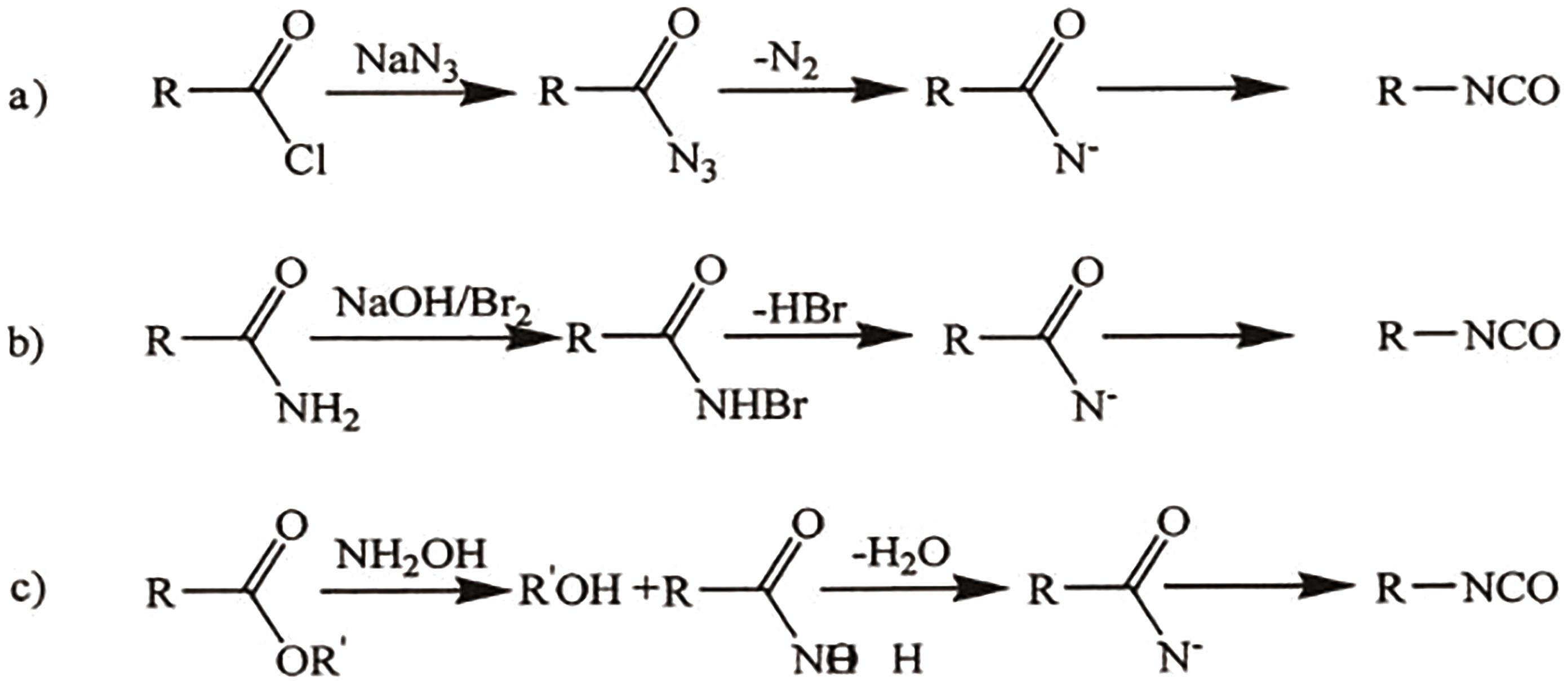
图4 用于生物基二异氰酸酯的化学重排: (a) Curtius重排、(b) Hoffman重排和(c) Lossen重排[32]
Fig.4 Chemical rearrangements for bio-based isocyanates: (a) Curtius rearrangements, (b) Hoffman rearrangements, and (c) Lossen rearrangements[32]
| Sample | Tg/℃ | Tensile strength/MPa | Elongation at break/% | Toughness/(MJ·m-3) | Young′s modulus/MPa |
|---|---|---|---|---|---|
| LBWPU-32% | -14.7 | 4.80±2.1 | 1 033±25 | 34.3±3.4 | 10.3±2.3 |
| LBWPU-38% | -13.8 | 11.3±3.5 | 1 015±16 | 61.0±2.7 | 19.7±3.1 |
| LBWPU-44% | -13.0 | 13.7±1.3 | 973±12 | 66.8±2.6 | 25.4±3.9 |
| LBWPU-48% | -12.1 | 21.5±2.9 | 802±31 | 82.5±4.9 | 51.2±2.9 |
| CBWPU-0.5% | -11.9 | 30.1±3.7 | 702±57 | 111±2.1 | 61.5±2.4 |
| CBWPU-1% | -11.0 | 41.5±1.7 | 663±35 | 131±1.0 | 87.6±3.7 |
| CBWPU-2% | -10.3 | 38.9±2.3 | 619±27 | 123±1.2 | 108±4.9 |
表1 BWPU的Tg和机械性能[40]
Table 1 Mechanical properties and Tg of BWPU[40]
| Sample | Tg/℃ | Tensile strength/MPa | Elongation at break/% | Toughness/(MJ·m-3) | Young′s modulus/MPa |
|---|---|---|---|---|---|
| LBWPU-32% | -14.7 | 4.80±2.1 | 1 033±25 | 34.3±3.4 | 10.3±2.3 |
| LBWPU-38% | -13.8 | 11.3±3.5 | 1 015±16 | 61.0±2.7 | 19.7±3.1 |
| LBWPU-44% | -13.0 | 13.7±1.3 | 973±12 | 66.8±2.6 | 25.4±3.9 |
| LBWPU-48% | -12.1 | 21.5±2.9 | 802±31 | 82.5±4.9 | 51.2±2.9 |
| CBWPU-0.5% | -11.9 | 30.1±3.7 | 702±57 | 111±2.1 | 61.5±2.4 |
| CBWPU-1% | -11.0 | 41.5±1.7 | 663±35 | 131±1.0 | 87.6±3.7 |
| CBWPU-2% | -10.3 | 38.9±2.3 | 619±27 | 123±1.2 | 108±4.9 |
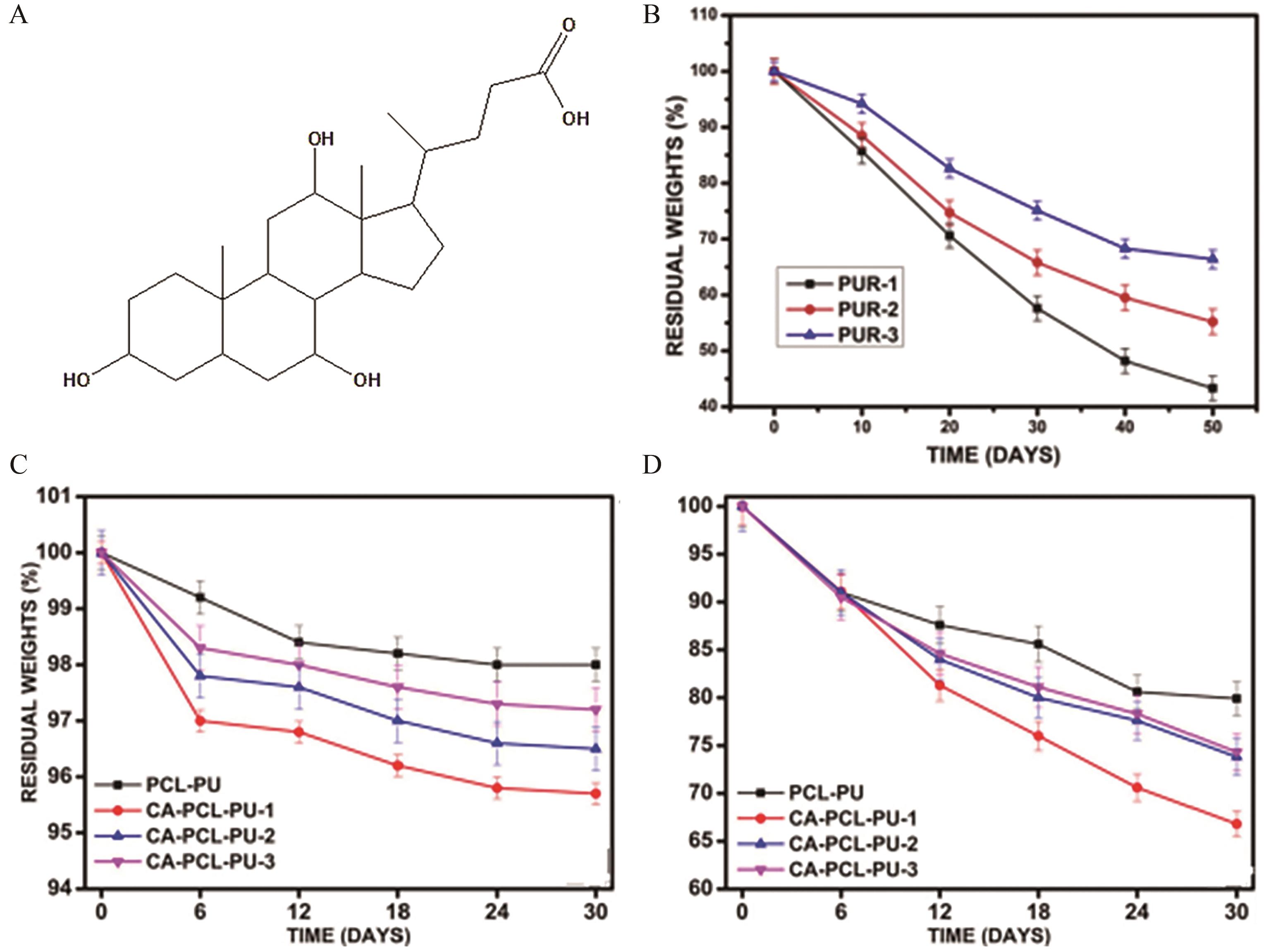
图6 (A)胆酸的结构式[41]; (B)在猪胰脂肪酶存在下酶促降解过程中聚氨酯(PURs)残余质量的百分比[42]; (C) PCL-PU和CA-PCL-PUs的水解降解[43]; (D) PCL-PU和CA-PCL-PUs的酶促降解[43]PUR-1: n(CA)∶n(LDI)=1∶1; PUR-2: n(CA)∶n(LDI)=1∶2; PUR-3: n(CA)∶n(LDI)=1∶3
Fig.6 (A) Structure of cholic acid[41]; (B) The percentage of residual mass of polyurethanes (PURs) during the course of enzymatic degradation in the presence of porcine pancreatic lipase[42]; (C) Hydrolytic degradation behaviors of PCL-PU and CA-PCL-PU[43]; (D) Enzymatic degradation of PCL-PU and CA-PCL-PUs[43]
| Sample | Tm/℃ | Tensile strength/MPa | Elongation at break/% | Young′s modulus/MPa |
|---|---|---|---|---|
| PCL-PU | 65 | 18.68 | 11.66 | 171.61 |
| CA-PCL-PU-1 | 53 | 9.37 | 243.29 | 121.48 |
| CA-PCL-PU-2 | 50 | 10.85 | 313.50 | 138.67 |
| CA-PCL-PU-3 | 45 | 11.57 | 327.26 | 157.71 |
表2 材料的熔融温度和力学性能[43]
Table 2 Melt temperature and mechanical properties of the materials[43]
| Sample | Tm/℃ | Tensile strength/MPa | Elongation at break/% | Young′s modulus/MPa |
|---|---|---|---|---|
| PCL-PU | 65 | 18.68 | 11.66 | 171.61 |
| CA-PCL-PU-1 | 53 | 9.37 | 243.29 | 121.48 |
| CA-PCL-PU-2 | 50 | 10.85 | 313.50 | 138.67 |
| CA-PCL-PU-3 | 45 | 11.57 | 327.26 | 157.71 |
| Sample | Molecular mass | Tg/℃ | Mechanical properties | ||||
|---|---|---|---|---|---|---|---|
| 10-4Mn | 10-4Mw | PDI | Tensile strength/MPa | Elongation at break/% | Young′s modulus/MPa | ||
| PU-BDA-530 | 30.45 | 65.17 | 2.14 | 3 | 2.4±0.1 | 327±28 | 1.8±0.5 |
| PU-R-530 | 7.22 | 16.33 | 2.26 | 3 | 1.6±0.5 | 667±84 | 0.6±0.2 |
| PU-G-530 | 12.16 | 16.57 | 1.36 | 5 | 2.1±0.5 | 571±73 | 0.8±0.2 |
| PU-D-530 | 3.06 | 15.00 | 4.90 | 5 | 0.9±0.1 | 116±8 | 0.9±0.1 |
表3 PU相对分子质量、Tg和力学性能[52]
Table 3 Relative Molecular mass, Tg and mechanical properties of PU[52]
| Sample | Molecular mass | Tg/℃ | Mechanical properties | ||||
|---|---|---|---|---|---|---|---|
| 10-4Mn | 10-4Mw | PDI | Tensile strength/MPa | Elongation at break/% | Young′s modulus/MPa | ||
| PU-BDA-530 | 30.45 | 65.17 | 2.14 | 3 | 2.4±0.1 | 327±28 | 1.8±0.5 |
| PU-R-530 | 7.22 | 16.33 | 2.26 | 3 | 1.6±0.5 | 667±84 | 0.6±0.2 |
| PU-G-530 | 12.16 | 16.57 | 1.36 | 5 | 2.1±0.5 | 571±73 | 0.8±0.2 |
| PU-D-530 | 3.06 | 15.00 | 4.90 | 5 | 0.9±0.1 | 116±8 | 0.9±0.1 |
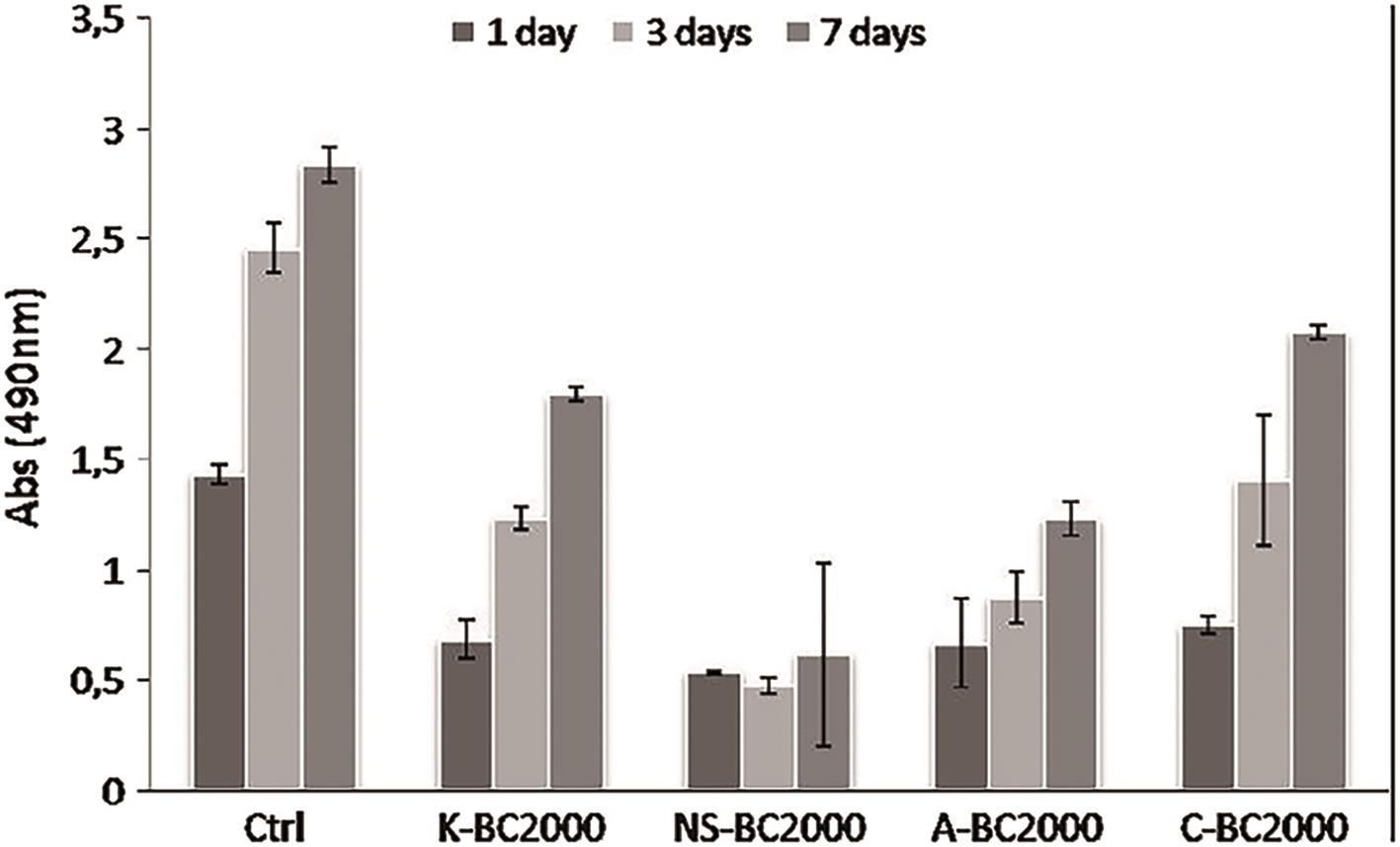
图8 聚苯乙烯细胞培养板(阳性对照)和合成的PUR上的骨骼成肌细胞生长。490 nm处的光吸光度与活细胞的数量成正比[56]
Fig.8 Skeletal myoblast growth on polystyrene cell culture plates (positive control) and the PURs. Optical absorbance at 490 nm is directly proportional to the amount of viable cells[56]
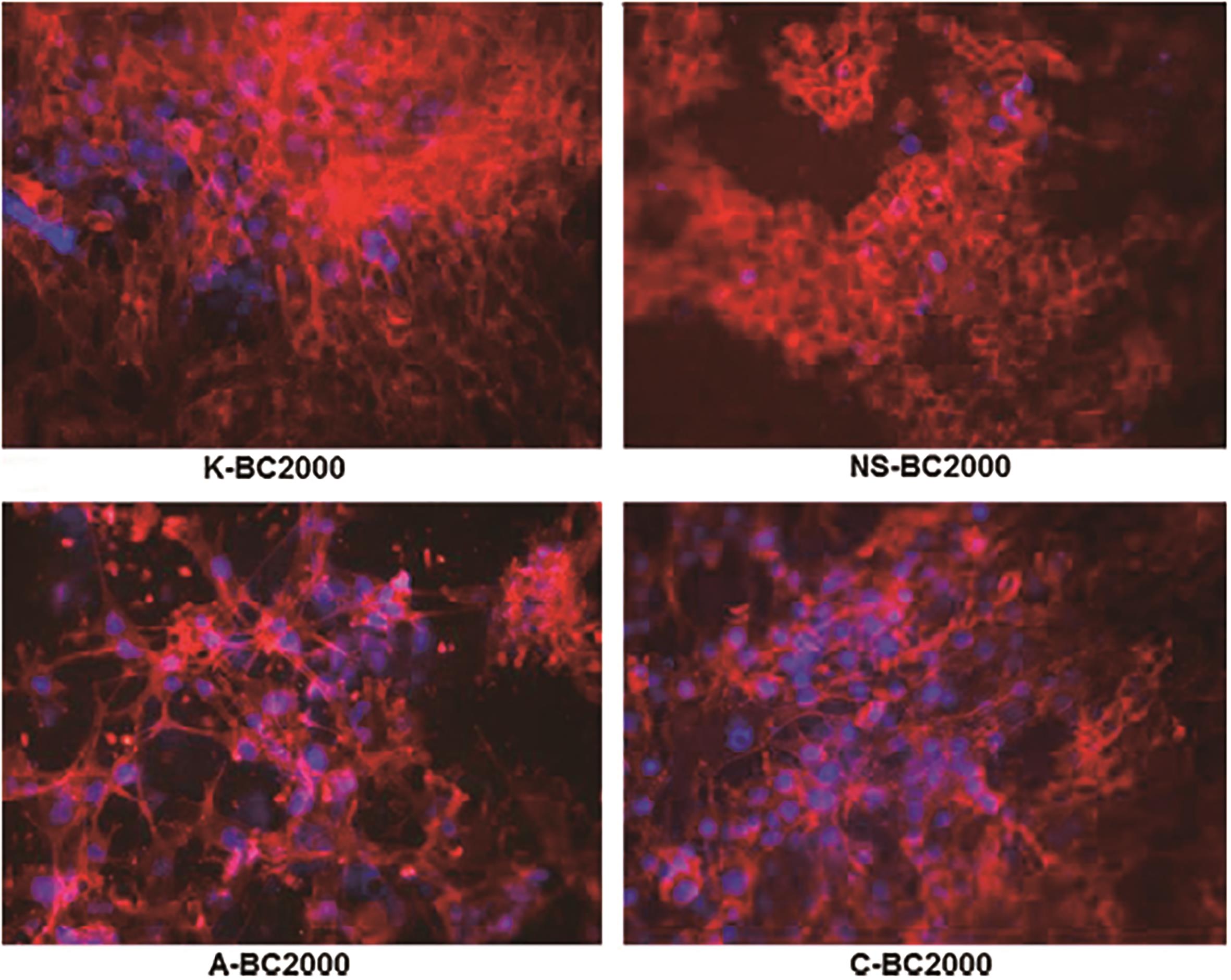
图9 在合成的聚氨酯上培养7 d的成肌细胞的肌动蛋白细胞骨架。样品用鬼笔环肽-TRITC 偶联物染色,该偶联物特异性结合肌动蛋白丝和DAPI,一种对DNA具有特异性的蓝色荧光染料[56]
Fig.9 Actin cytoskeleton of myoblasts cultured for 7 days on the synthesised polyurethanes. Samples were stained with phalloidin-TRITC conjugated which specifically binds actin filaments and DAPI, a blue fluorescent dye specific for DNA[56]
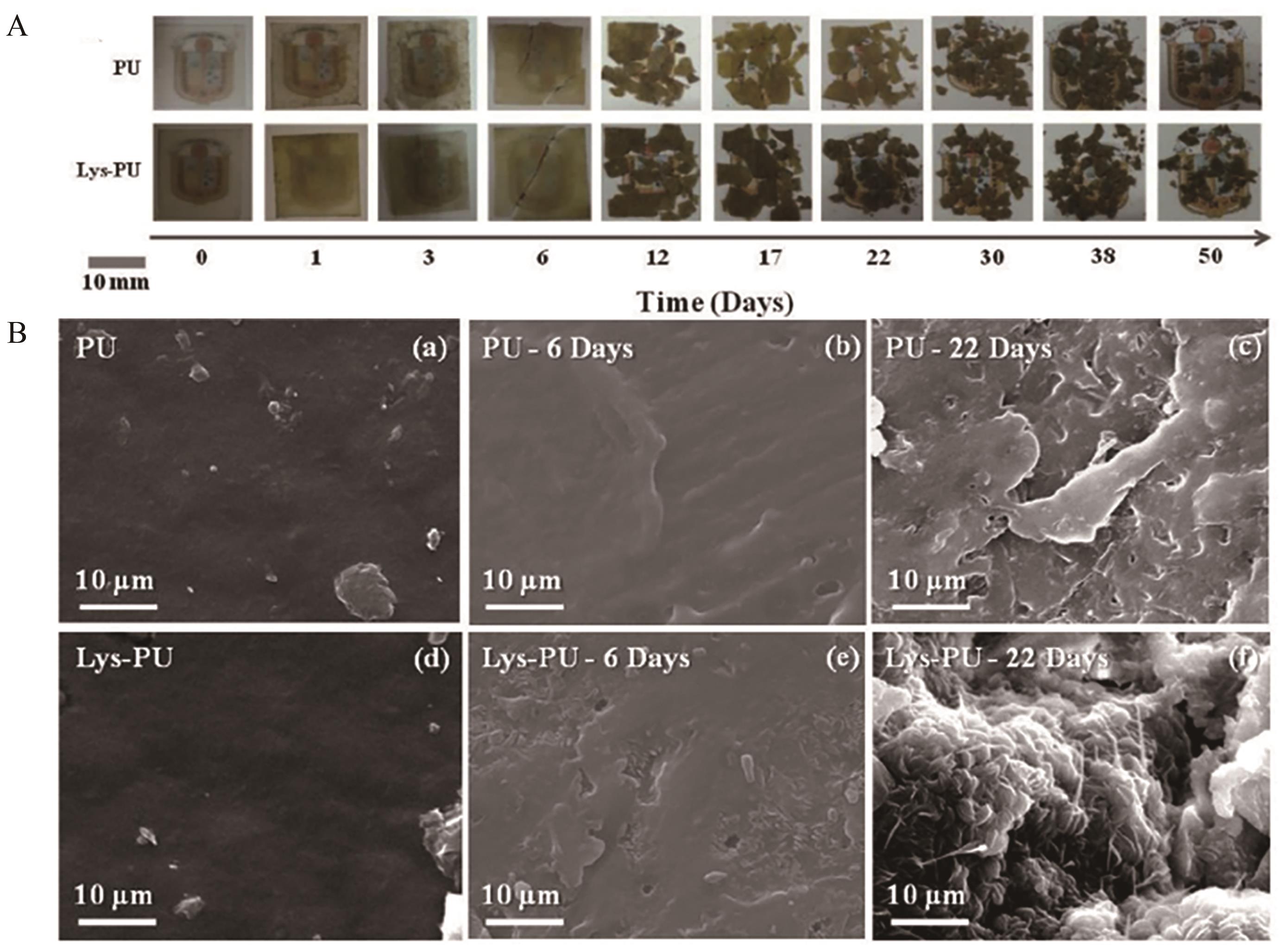
图10 (A)堆肥条件下降解不同天数PU薄膜样品的视觉外观; (B)堆肥条件下PU和lys-PU回收薄膜在不同降解天数的 SEM 观察[57]
Fig.10 (A) Visual appearance of PU film samples after different days of degradation under composting conditions; (B) SEM observations of PU and lys-PU recovered films at different degradation time under composting conditions[57]
| 1 | CALVO-CORREAS T, MARTIN M D, RETEGI A, et al. Synthesis and characterization of polyurethanes with high renewable carbon content and tailored properties[J]. ACS Sustainable Chem Eng, 2016, 4(10): 5684-5692. |
| 2 | AKINDOYO J O, BEG M D H, GHAZALI S, et al. Polyurethane types, synthesis and applications-a review[J]. RSC Adv, 2016, 6(115): 114453-114482. |
| 3 | BAYER O. The diisocyanate polyaddition process (polyurethane)[J]. Angew Chem, 1947, 59(9): 257-272. |
| 4 | SKLENICKOVÁ K, ABBRENT S, HALECKY M, et al. Biodegradability and ecotoxicity of polyurethane foams: a review[J]. Crit Rev Environ Sci Technol, 2022, 52(2): 157-202. |
| 5 | 范鑫, 王欢, 黄峻榕. 生物基聚氨酯泡沫研究进展及其在食品包装中的应用[J]. 食品研究与开发, 2023, 44(24): 156-162. |
| FAN X, WANG H, HUANG J R. Research progress in bio-based polyurethane foam and its application in food packaging[J]. Food Res Dev, 2023, 44(24): 156-162. | |
| 6 | HU J, MO R, SHENG X, et al. A self-healing polyurethane elastomer with excellent mechanical properties based on phase-locked dynamic imine bonds[J]. Polym Chem, 2020, 11(14): 2585-2594. |
| 7 | 韦代东, 李惠枝, 曾娟娟, 等. 生物基聚氨酯抗涂鸦自清洁涂料的制备及性能[J]. 中国塑料, 2023, 37(2): 15-21. |
| WEI D D, LI H Z, ZENG J J, et al. Preparation and performance of biobased polyurethane anti-graffiti and self-cleaning coating[J]. China Plast, 2023, 37(2): 15-21. | |
| 8 | 周永红, 潘政, 张猛. 生物基聚氨酯材料的研究进展[J]. 生物质化学工程, 2023, 57(1): 1-12. |
| ZHOU Y H, PAN Z, ZHANG M. Recent progress in synthesis and application of bio-based polyurethanes[J]. Biomass Chem Eng, 2023, 57(1): 1-12. | |
| 9 | YU N, AN Z, ZHANG J, et al. Recent advances in tailored fabrication and properties of biobased self-healing polyurethane[J]. Biomacromolecules, 2023, 24(11): 4605-4621. |
| 10 | DE SOUZA F M, KAHOL P K, GUPTA R K. Polyols from sustainable resources[M]//GUPTA R K, KAHOL P K. Washington, DC: American Chemical Society, 2021: 25-49. |
| 11 | PARASKAR P M, PRABHUDESAI M S, HATKAR V M, et al. Vegetable oil based polyurethane coatings-a sustainable approach: a review[J]. Prog Org Coat, 2021, 156: 106267. |
| 12 | KUGLER S, OSSOWICZ P, MALARCZYK-MATUSIAK K, et al. Advances in rosin-based chemicals: the latest recipes, applications and future trends[J]. Molecules, 2019, 24(9): 1651. |
| 13 | MAISONNEUVE L, CHOLLET G, GRAU E, et al. Vegetable oils: a source of polyols for polyurethane materials[J]. OCL: Oilseeds Fats, Crops Lipids, 2016, 23(5): D508. |
| 14 | ZHU Y, GAO F, ZHONG J, et al. Renewable castor oil and DL-limonene derived fully bio-based vinylogous urethane vitrimers[J]. Eur Polym J, 2020, 135: 109865. |
| 15 | 赵梅, 刘馨远, 陈洋, 等. 基于非天然氨基酸的蛋白质合成研究进展[J]. 食品与发酵工业, 2024, 50(12): 336-342. |
| ZHAO M, LIU X Y, CHEN Y, et al. Research progress on protein synthesis based on unnatural amino acids[J]. Food Ferment Ind, 2024, 50(12): 336-342. | |
| 16 | 刘慧, 刘骁, 曹远桥, 等. 氨基酸基聚合物在抗菌领域的研究进展[J]. 应用化学, 2021, 38(5): 559-571. |
| LIU H, LIU X, CAO Y Q, et al. Research progress on amino acid-based antimicrobial polymers[J]. Chin J Appl Chem, 2021, 38(5): 559-571. | |
| 17 | CHARLON M, HEINRICH B, MATTER Y, et al. Synthesis, structure and properties of fully biobased thermoplastic polyurethanes, obtained from a diisocyanate based on modified dimer fatty acids, and different renewable diols[J]. Eur Polym J, 2014, 61: 197-205. |
| 18 | BROCAS A, MANTZARIDIS C, TUNC D, et al. Polyether synthesis: from activated or metal-free anionic ring-opening polymerization of epoxides to functionalization[J]. Prog Polym Sci, 2013, 38(6): 845-873. |
| 19 | HUANG S, LIU G, ZHANG K, et al. Water-based polyurethane formulations for robust superhydrophobic fabrics[J]. Chem Eng J, 2019, 360: 445-451. |
| 20 | LU W, WANG X, CHENG R, et al. Biocompatible and bioreducible micelles fabricated from novel α-amino acid-based poly(disulfide urethane)s: design, synthesis and triggered doxorubicin release[J]. Polym Chem, 2015, 6(33): 6001-6010. |
| 21 | ZHOU L, LIANG D, HE X, et al. The degradation and biocompatibility of pH-sensitive biodegradable polyurethanes for intracellular multifunctional antitumor drug delivery[J]. Biomaterials, 2012, 33(9): 2734-2745. |
| 22 | XIE Z, LU C, CHEN X, et al. A facile approach to biodegradable poly(ε-caprolactone)-poly(ethylene glycol)-based polyurethanes containing pendant amino groups[J]. Eur Polym J, 2007, 43(5): 2080-2087. |
| 23 | COHN D, HOTOVELY-SALOMON A. Biodegradable multiblock PEO/PLA thermoplastic elastomers: molecular design and properties[J]. Polymer, 2005, 46(7): 2068-2075. |
| 24 | GAVHANE U A, JOSHI D C, JAYAKANNAN M. Size- and shape-controlled biodegradable polymer brushes based on L-amino acid for intracellular drug delivery and deep-tissue penetration[J]. Biomacromolecules, 2024, 25(6): 3756-3774. |
| 25 | DATTA J, KASPRZYK P. Thermoplastic polyurethanes derived from petrochemical or renewable resources: a comprehensive review[J]. Polym Eng Sci, 2018, 58(S1): E14-E35. |
| 26 | PARCHETA P, DATTA J. Environmental impact and industrial development of biorenewable resources for polyurethanes[J]. Crit Rev Environ Sci Technol, 2017, 47(20): 1986-2016. |
| 27 | JAVNI I, ZHANG W, PETROVIĆ Z S. Effect of different isocyanates on the properties of soy-based polyurethanes[J]. J Appl Polym Sci, 2003, 88(13): 2912-2916. |
| 28 | EWA G, PAULINA P, PAULINA K, et al. Polyisocyanates from sustainable resources[M]//GUPTA R K, KAHOL P K. Washington, DC: American Chemical Society, 2021: 51-73. |
| 29 | BŁAŻEK K, DATTA J. Renewable natural resources as green alternative substrates to obtain bio-based non-isocyanate polyurethanes-review[J]. Crit Rev Environ Sci Technol, 2019, 49(3): 173-211. |
| 30 | PRUEITT R L, LYNCH H N, ZU K, et al. Dermal exposure to toluene diisocyanate and respiratory cancer risk[J]. Environ Int, 2017, 109: 181-192. |
| 31 | LUNA L G, GREEN B J, ZHANG F, et al. Quantitation of 4,4′-methylene diphenyl diisocyanate human serum albumin adducts[J]. Toxicol Rep, 2014, 1: 743-751. |
| 32 | ÇAYLI G, KÜSEFOĞLU S. Biobased polyisocyanates from plant oil triglycerides: synthesis, polymerization, and characterization[J]. J Appl Polym Sci, 2008, 109(5): 2948-2955. |
| 33 | GHOSH A K, SARKAR A, BRINDISI M. The Curtius rearrangement: mechanistic insight and recent applications in natural product syntheses[J]. Org Biomol Chem, 2018, 16(12): 2006-2027. |
| 34 | WALLIS E S, LANE J F. The Hofmann reaction[M]//Hoboken, New Jersey: John Wiley and Sons, Inc, 2011: 267-306. |
| 35 | ABDELHAFEZ E M N, ALY O M, ABUO-RAHMA G E A A, et al. Lossen rearrangements under Heck reaction conditions[J]. Adv Synth Catal, 2014, 356(16): 3456-3464. |
| 36 | ROKICKI G, PARZUCHOWSKI P G, MAZUREK M. Non-isocyanate polyurethanes: synthesis, properties, and applications[J]. Polym Adv Technol, 2015, 26(7): 707-761. |
| 37 | KHATOON H, IQBAL S, IRFAN M, et al. A review on the production, properties and applications of non-isocyanate polyurethane: a greener perspective[J]. Prog Org Coat, 2021, 154: 10612. |
| 38 | LI Y, NOORDOVER B A J, VAN BENTHEM R A T M, et al. Reactivity and regio-selectivity of renewable building blocks for the synthesis of water-dispersible polyurethane prepolymers[J]. ACS Sustainable Chem Eng, 2014, 2(4): 788-797. |
| 39 | KARBASI A, DARVISHI R, ENAYATI GERDROODBAR A, et al. Kinetic analysis of the reaction between tannic acid (TA) and L-lysine diisocyanate (LDI) systems[J]. Int J Polym Sci, 2023, 2023: 1-11. |
| 40 | XUE M, RAO X, LI W, et al. Waterborne polyurethane synthesized for leather with excellent wear and hydrolysis resistance enabled by bio-based poly(trimethylene carbonate) and L-lysine diisocyanate[J]. Prog Org Coat, 2024, 193: 108553. |
| 41 | LI C, LAVIGUEUR C, ZHU X X. Aggregation and thermoresponsive properties of new star block copolymers with a cholic acid core[J]. Langmuir, 2011, 27(17): 11174-11179. |
| 42 | ACIK G, KARABULUT H R F, ALTINKOK C, et al. Synthesis and characterization of biodegradable polyurethanes made from cholic acid and L-lysine diisocyanate ethyl ester[J]. Polym Degrad Stab, 2019, 165: 43-48. |
| 43 | ACIK B, ACIK G, ERDEMI H. Synthesis and characterization of bile acid, poly(ε-caprolactone) and L-lysine diisocyanate ethyl ester based polyurethanes and investigation of their biodegradability properties[J]. Eur Polym J, 2021, 146: 110247. |
| 44 | CHATTOPADHYAY D K, WEBSTER D C. Thermal stability and flame retardancy of polyurethanes[J]. Prog Polym Sci, 2009, 34(10): 1068-1133. |
| 45 | LI W, LI H, WU C, et al. An effective synthesis of bio-based pentamethylene diisocyanate in a jet loop reactor[J]. Chem Eng J, 2021, 425: 131527. |
| 46 | HE F, TANG Y, LU Z, et al. An effective purification of double-effect distillation for bio-based pentamethylene diisocyanate[J]. RSC Adv, 2023, 13(45): 31518-31527. |
| 47 | JASIŪNAS L, PECK G, BRIDŽIUVIENĖ D, et al. Mechanical, thermal properties and stability of high renewable content liquefied residual biomass derived bio-polyurethane wood adhesives[J]. Int J Adhes Adhes, 2020, 101: 102618. |
| 48 | SHEIKHY H, SHAHIDZADEH M, RAMEZANZADEH B, et al. Studying the effects of chain extenders chemical structures on the adhesion and mechanical properties of a polyurethane adhesive[J]. J Ind Eng Chem, 2013, 19(6): 1949-1955. |
| 49 | ONIKI Y, SUZUKI K, HIGAKI Y, et al. Molecular design of environmentally benign segmented polyurethane(urea)s: effect of the hard segment component on the molecular aggregation states and biodegradation behavior[J]. Polym Chem, 2013, 4(13): 3735-3743. |
| 50 | ZHENG N, FANG Z, ZOU W, et al. Thermoset shape-memory polyurethane with intrinsic plasticity enabled by transcarbamoylation[J]. Angew Chem, 2016, 128(38): 11593-11597. |
| 51 | GUELCHER S A, GALLAGHER K M, DIDIER J E, et al. Synthesis of biocompatible segmented polyurethanes from aliphatic diisocyanates and diurea diol chain extenders[J]. Acta Biomater, 2005, 1(4): 471-484. |
| 52 | CHAN-CHAN L H, GONZÁLEZ-GARCÍA G, VARGAS-CORONADO R F, et al. Characterization of model compounds and poly(amide-urea) urethanes based on amino acids by FTIR, NMR and other analytical techniques[J]. Eur Polym J, 2017, 92: 27-39. |
| 53 | LU Q W, HOYE T R, MACOSKO C W. Reactivity of common functional groups with urethanes: models for reactive compatibilization of thermoplastic polyurethane blends[J]. J Polym Sci, Part A: Polym Chem, 2002, 40(14): 2310-2328. |
| 54 | VENEGAS-CERVERA G A, OLIVA A I, AVILA-ORTEGA A, et al. Biocompatibility studies of polyurethane electrospun membranes based on arginine as chain extender[J]. J Mater Sci: Mater Med, 2021, 32(9): 104. |
| 55 | GUPTA S S, MISHRA V, MUKHERJEE M D, et al. Amino acid derived biopolymers: recent advances and biomedical applications[J]. Int J Biol Macromol, 2021, 188: 542-567. |
| 56 | SARTORI S, BOFFITO M, SERAFINI P, et al. Synthesis and structure-property relationship of polyester-urethanes and their evaluation for the regeneration of contractile tissues[J]. React Funct Polym, 2013, 73(10): 1366-1376. |
| 57 | ARRIETA M P, RIVERA K, SALGADO C, et al. Degradation under composting conditions of lysine-modified polyurethane based on PCL obtained by lipase biocatalysis[J]. Polym Degrad Stab, 2018, 152: 139-146. |
| 58 | CALVO-CORREAS T, SHIROLE A, CRIPPA F, et al. Biocompatible thermo- and magneto-responsive shape-memory polyurethane bionanocomposites[J]. Mater Sci Eng, C, 2019, 97: 658-668. |
| 59 | GNANASEKAR P, CHEN H, LUO Q, et al. Mechanically robust, degradable, catalyst-free fully bio-based shape memory polyurethane: influence of a novel vanillin-alaninol chain extender[J]. ACS Sustainable Chem Eng, 2022, 10(16): 5203-5211. |
| 60 | GRZELAK A W, BOINARD P, LIGGAT J J. The influence of diol chain extender on morphology and properties of thermally-triggered UV-stable self-healing polyurethane coatings[J]. Prog Org Coat, 2018, 122: 1-9. |
| 61 | YING W B, YU Z, KIM D H, et al. Waterproof, highly tough, and fast self-healing polyurethane for durable electronic skin[J]. ACS Appl Mater Interfaces, 2020, 12(9): 11072-11083. |
| 62 | XU B, YIN Q, HAN F, et al. A Bio-based healable/renewable polyurethane elastomer derived from L-tyrosine/vanillin/dimer acid[J]. Chem Eng Sci, 2022, 258: 117736. |
| [1] | 李远杰, 范冰冰, 张君丽, 周艳梅. 氨基酸离子液体在能量存储和生物质资源化中的研究进展[J]. 应用化学, 2024, 41(3): 391-404. |
| [2] | 洪韵, 马晓野, 侯靖威, 蒋丁晓, 康传清. 含丝素蛋白多肽结构聚氨酯的制备及其性能[J]. 应用化学, 2024, 41(10): 1425-1435. |
| [3] | 史俊杰, 史哲航, 李红周. 磷系阻燃剂插层镁铝型水滑石复合物的制备及其在热塑性聚氨酯中的阻燃应用[J]. 应用化学, 2023, 40(9): 1288-1301. |
| [4] | 陈玉竹, 刘思思, 张蒙蒙, 林祥德, 曾冬冬. 基于抗菌性壳聚糖/羧甲基纤维素复合药物涂层的聚氨酯敷料[J]. 应用化学, 2023, 40(2): 252-260. |
| [5] | 石碧茹, 武浩浩, 谢昊圃, 田新欣, 孙莹潞, 刘向东, 杨宇明. Diels-Alder型自修复聚氨酯胶粘剂的制备及其性能[J]. 应用化学, 2023, 40(2): 277-287. |
| [6] | 张丹, 刘芳, 杨雪, 许东华, 石彤非. 热塑性聚氨酯共混物的硬度与冲击性能的关系[J]. 应用化学, 2022, 39(8): 1216-1223. |
| [7] | 李颖, 张云, 林良良, 许虎君. N‑月桂酰基甲基丙氨酸钠三元复配体系的协同效应[J]. 应用化学, 2022, 39(8): 1262-1273. |
| [8] | 刘慧, 刘骁, 曹远桥, 刘明, 刘亚栋, 韩苗苗, 季生象. 氨基酸基聚合物在抗菌领域的研究进展[J]. 应用化学, 2021, 38(5): 559-571. |
| [9] | 吕兆丰, 陈世珩, 王楠, 白翠, 肖丹. 反相高效液相色谱-质谱联用法分析蝙蝠蛾拟青霉菌发酵液中抑菌肽类物质的氨基酸序列[J]. 应用化学, 2021, 38(3): 298-304. |
| [10] | 吴秋萍, 蔡昆廷, 王元康, 孙凯, 杨金波, 韩松柏, 刘蕴韬. Co/C微波吸收性能及Co/C-聚氨酯相变复合材料的微波-热转换性能[J]. 应用化学, 2021, 38(12): 0-0. |
| [11] | 吴秋萍, 蔡昆廷, 王元康, 孙凯, 杨金波, 韩松柏, 刘蕴韬. Co/C微波吸收性能及Co/C-聚氨酯相变复合材料的微波-热转换性能[J]. 应用化学, 2021, 38(12): 1588-1598. |
| [12] | 张帅, 陶友华. 两种功能化环状赖氨酸单体的合成[J]. 应用化学, 2021, 38(12): 1676-1678. |
| [13] | 张思佳, 徐彩娜, 陈杰, 田华雨, 陈学思. 通过调控肿瘤代谢增强T细胞抗肿瘤活性[J]. 应用化学, 2020, 37(9): 977-984. |
| [14] | 李茂盛, 陈金龙, 陶友华. 氨基酸功能化环辛烯单体的区域及立体选择性开环易位聚合[J]. 应用化学, 2020, 37(3): 280-292. |
| [15] | 潘鸽, 刘芳, 付志磊, 李双双, 许东华, 徐朝华, 石彤非, 王晓伟, 马蕊. 不同色浆质量分数的水性聚氨酯涂料对聚氯乙烯表皮低温爆破性能的影响[J]. 应用化学, 2020, 37(2): 182-189. |
| 阅读次数 | ||||||
|
全文 |
|
|||||
|
摘要 |
|
|||||
